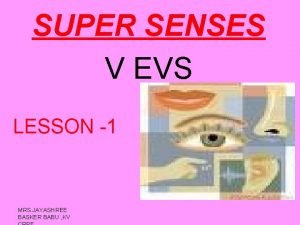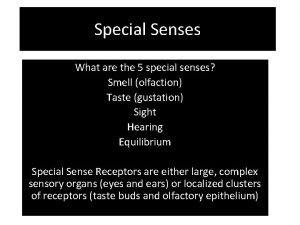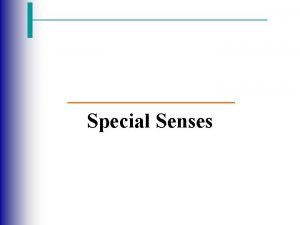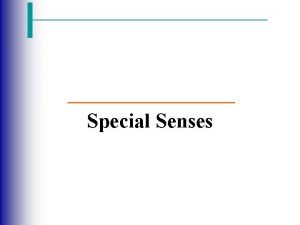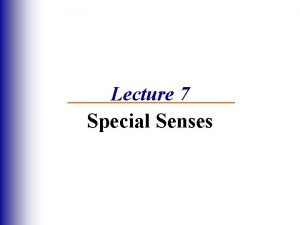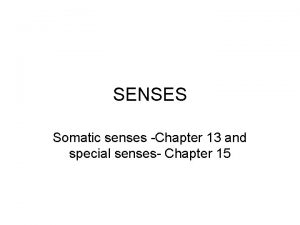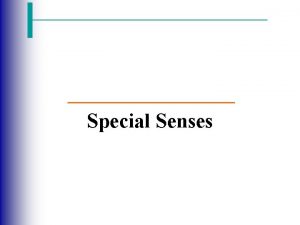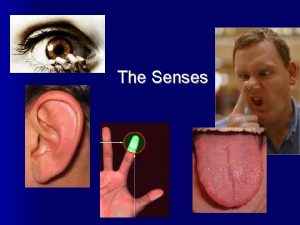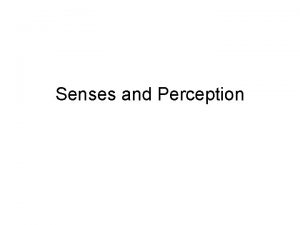l Hearing is one of the five senses























- Slides: 23


l Hearing is one of the five senses. l It is a complex process of picking up sound attaching meaning to it. l The ability to hear is critical to understanding the world around us.

l The human ear is a fully developed part of our bodies at birth and responds to sounds, that are very faint as well as sounds that are very loud. l Even before birth, infants respond to sound. l So, how do we hear?

Parts of the ear l Outer ear l Middle ear l Inner ear

Three parts of the ear l The ear is made up of three primary parts: the outer ear, middle ear and inner ear. l Each section is composed of structures that play distinct roles in the process of converting sound waves into signals that go to the brain

Outer ear l The outer ear is composed of the visible part of the ear (pinna), the ear canal and the eardrum.

l The cup-shaped pinna gathers sound waves from the environment and directs them into the ear canal l When a sound wave strikes, the eardrum vibrates.

Aurical l Aurical is the part we see outside l It is cone shaped and attached either side, at about 30 to 40 degree l The deep portion in the center is called Concha l There is no bone in the auricles. l It has blood and nerve supply.

External Auditory Canal l It is an S shaped tube open at the pinna and closed at the ear drum. l It measures about 25 -40 mm. l The outer portion of the canal has hairs on the skin. l It also has Wax-Secreting glands. l Ear canal also has blood and nerve supply

Middle Ear The middle ear consists of the smallest bones in your body and Ear Drum. l Malleus l Incus l Stapes l

l The middle ear is an air-filled cavity that holds a chain of three bones: the hammer, anvil and stirrup. l The middle ear is connected to the back of your nose and upper part of your throat by a narrow channel called the auditory tube.

l The tube opens and closes at the throatend to refresh the air in the middle ear, . l Equal pressure on both sides of the eardrum is important for normal vibration of the eardrum.

Bones of the middle ear l The middle ear contains three tiny bones, including the: l Hammer (malleus), which is attached to eardrum.

l Anvil (incus), which is in the middle of the chain of bones. l Stirrup (stapes), which is attached to the oval window, the membranecovered opening to the inner ear.

l It is the smallest bone Its wt is 2. 5 mg l The vibration of the eardrum triggers a chain of vibrations through the bones. l Because of differences in the size, shape and position of the three bones, the force of the vibration increases by the time it reaches the inner ear.

l This increase in force is necessary to transfer the energy of the sound wave to the fluid of the inner ear.

Inner ear l The inner ear contains a group of interconnected, fluid-filled chambers. l The snail-shaped chamber, called the cochlea plays a role in hearing.

l Sound vibrations from the bones of the middle ear are transferred to the fluids of the cochlea. l Tiny sensors (hair cells) line in the cochlea convert the vibrations into electrical impulses that are transmitted along the auditory nerve to your brain.

l The other fluid-filled chambers of the inner ear include three tubes called the semicircular canals (vestibular labyrinth). l Hair cells in the semicircular canals detect the motion of the fluids when you move in any direction.

l They convert the motion into electrical signals that are transmitted along the vestibular nerve to the brain. l This sensory information enables you to maintain your sense of balance.

Traveling to the brain l Electrical impulses travel along the auditory nerve and pass through several information -processing centers. Signals from the right ear travel to the Auditory Cortex located in the temporal lobe on the left side of the brain. l

l Signals from the left ear travel to the right auditory cortex. l The auditory cortex, process, interpret and file information about the sound. l The comparison and analysis of the all the signals that reach the brain enable you to detect certain sounds and suppress other sounds as background noise.

SO THAT’S HOW WE HEAR!!! Any quesions or comments?
 5 senses and 5 elements
5 senses and 5 elements What is the difference between somatic and special senses
What is the difference between somatic and special senses General senses vs special senses
General senses vs special senses Describing the beach using 5 senses
Describing the beach using 5 senses Descriptive essay beach using five senses
Descriptive essay beach using five senses Bio poem definition
Bio poem definition Super senses of tiger ppt
Super senses of tiger ppt On your notebook
On your notebook Five special senses
Five special senses One god one empire one religion
One god one empire one religion One one one little dog run
One one one little dog run One king one law one faith
One king one law one faith One empire one god one emperor
One empire one god one emperor One ford plan
One ford plan See one do one teach one
See one do one teach one See one, do one, teach one
See one, do one, teach one Night structure
Night structure Studiendekanat uni bonn
Studiendekanat uni bonn Asean tourism strategic plan
Asean tourism strategic plan Graphic organizer with the aims of la liga filipina
Graphic organizer with the aims of la liga filipina Five years have past five summers with the length
Five years have past five summers with the length Five of five
Five of five Macbeth act five scene five
Macbeth act five scene five Hát kết hợp bộ gõ cơ thể
Hát kết hợp bộ gõ cơ thể






